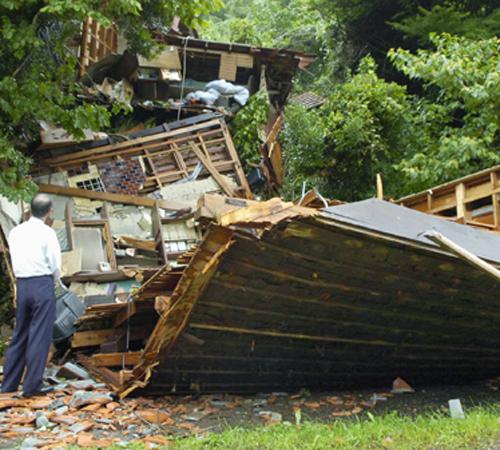Strong quake rocks northwestern Japan, kills 8, causes fire and leak at nuclear power plant

A man looks at a collapsed house which was caused by landslide due to a typhoon in Isumi city, Chiba prefecture, east of Tokyo, Sunday, July 15, 2007. A typhoon expected to hit Tokyo missed the capital and moved toward northeastern Japan on Sunday after l Kyodo News
Jul 16, 2007
Last updated on May 12, 2016 at 01:33 p.m.
KOJI SASAHARA
KASHIWAZAKI, Japan – A strong earthquake struck northwestern Japan on Monday, causing a fire and radioactive water leak at the world’s largest nuclear plant. At least eight people were killed and hundreds injured in the 6.8 magnitude quake that collapsed wooden houses, ripped apart roads and buckled seaside bridges.
Flames and billows of black smoke poured from the Kashiwazaki nuclear plant – the world’s largest in terms of power output capacity. It took two hours to extinguish the fire in an electrical transformer, said Motoyasu Tamaki, a Tokyo Electric Power Co. official.
The plant leaked about 315 gallons of water, said Katsuya Uchino, another Tokyo Electric official. Uchino said the water contained a tiny amount of radioactive material and is believed to have flushed into the Sea of Japan.
Get The Daily Illini in your inbox!
“The radioactivity is one-billionth of the legal limit,” Oshima said.
The quake, which left fissures 3 feet wide in the ground along the coast, hit shortly after 10 a.m. local time and was centered off Niigata state. Buildings swayed 160 miles away in Tokyo. Sirens wailed in Kashiwazaki, a city of about 90,000, which appeared to be hardest hit.
Japan’s Meteorological Agency measured the quake at a 6.8 magnitude. Near midnight Monday, another 6.8-magnitude quake hit off Japan’s west coast, according to the U.S. Geological Survey, which said the initial quake registered 6.7.
“I was so scared – the violent shaking went on for 20 seconds,” Ritei Wakatsuki, who was on her job in a convenience store in Kashiwazaki. “I almost fainted by the fear of shaking.”
Tokyo Electric said the water leak had stopped and that there had been no “significant change” in the seawater under surveillance and no effect on the environment, but the developments at Kashiwazaki triggered fresh concern about the earthquake resistance of Japan’s nuclear power plants, which supply nearly a third of the country’s electricity.
Aileen Mioko Smith, of the environmentalist group Green Action, said the fire showed that some facilities at nuclear power plants such as electrical transformers were built to lower quake-resistance levels than other equipment such as reactor cores.
“That’s the Achilles heel of nuclear power plants,” said Mioko Smith, who said it took the plant two hours to extinguish the fire. “Today’s a good example of that… How prepared are they to put out fires when they happen?
The Kashiwazaki-Kariwa plant is the world’s largest nuclear power facility with an output capacity of 8.21 million kilowatts. By comparison, the largest U.S. nuclear power facility, in Palo Verde, Ariz., has an output capacity of 3.88 million kilowatts, according to the Nuclear Energy Institute.
The quake hit on Marine Day, a national holiday in Japan, when most people would have been at home.
Four women and three men – all either in their 70s or 80s – were killed, according to the National Police Agency in Tokyo and NHK, which reported more than 800 people were hurt.
Nearly 300 homes in Kashiwazaki – a city known mainly for its fishing industry – were destroyed and some 2,000 people evacuated, officials said.
A ceiling collapsed in a gym in Kashiwazaki where about 200 people had gathered for a badminton tournament, and one person was hurt, Kyodo reported. The quake also knocked a train car off the rails while it was stopped at a station. No one was injured.
Several bullet train services linking Tokyo to northern and northwestern Japan were suspended.
Prime Minister Shinzo Abe – whose ruling party is trailing in the polls – interrupted a campaign stop in southern Japan for upcoming parliamentary elections, rushed back to Tokyo and announced he would head to the damaged area. He later arrived in a blue uniform to survey the damage.
“Many people told me they want to return to their normal lives as quickly as possible,” Abe told reporters in Kashiwazaki. “The government will make every effort to help with recovery.”
Japan sits atop four tectonic plates and is one of the world’s most earthquake-prone countries. The last major quake to hit the capital, Tokyo, killed some 142,000 people in 1923, and experts say the capital has a 90 percent chance of suffering a major quake in the next 50 years.
In October 2004, a magnitude-6.8 earthquake hit Niigata, killing 40 people and damaging more than 6,000 homes. It was the deadliest to hit Japan since 1995, when a magnitude-7.2 quake killed 6,433 people in the western city of Kobe.
Associated Press writers Kozo Mizoguchi and Chisaki Watanabe in Tokyo contributed to this report.





